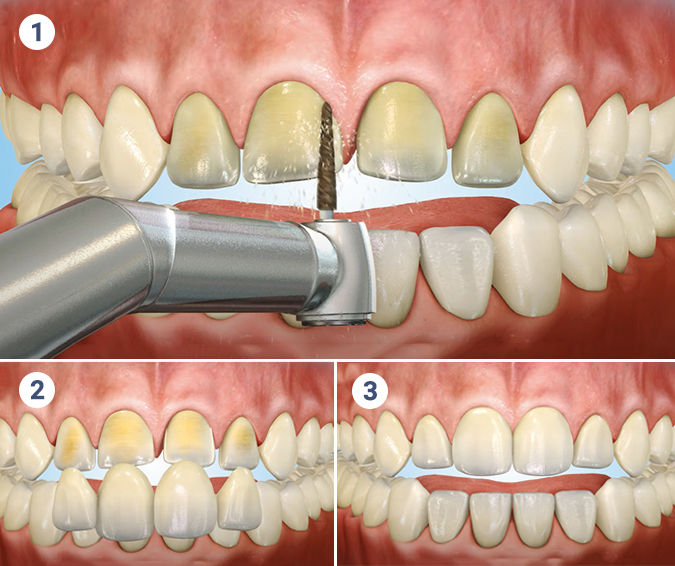The Complete Overview of Veneers: Types, Uses, and Their Influence on Your Smile
Veneers act as a prominent option for individuals looking for to improve their dental visual appeals. These custom-crafted coverings can effectively mask blemishes such as staining and voids. With two key kinds offered, porcelain and composite material, each offers unique benefits and restrictions. The impact of veneers extends past simple appearance, influencing self-esteem and social interactions. Recognizing their advantages and kinds is necessary. What might this indicate for one's overall high quality of life?
Recognizing Veneers: What They Are and How They Function
Veneers are thin coverings, normally made from porcelain or composite material, that are custom-crafted to fit over the front surface of teeth. They offer both functional and aesthetic purposes, giving a solution for various dental blemishes such as staining, voids, and minor misalignments. By adhering to the tooth enamel, veneers create an all-natural look while enhancing the shape and color of the teeth.
The procedure typically entails a first assessment, where a dentist analyzes the patient's demands and reviews wanted end results - Veneers Teeth. Following this, a minimal amount of enamel may be removed to fit the veneer. Impressions of the teeth are after that required to assure an accurate fit. When made, the veneers are bonded securely to the teeth making use of an unique dental adhesive. This procedure not just boosts the smile's appearance yet likewise assists secure the underlying teeth from more damages, making veneers a prominent option for several looking for a smile makeover
Sorts of Veneers: Porcelain vs. Compound Material
The difference between porcelain and composite material veneers lies in their product make-up and attributes. Each kind offers differing degrees of cost, durability, and resilience, influencing clients' choices based on their specific demands. Comprehending these differences is important for making an educated choice concerning oral improvements.
Product Differences Clarified
While both porcelain and composite resin veneers offer the exact same cosmetic objective, they vary considerably in product buildings, toughness, and aesthetic end results. Porcelain veneers are crafted from a ceramic material that imitates the natural translucence of teeth, offering a lifelike look. Their smooth surface is immune to staining, making them an attractive choice for those looking for a durable aesthetic. In contrast, composite resin veneers are made from a tooth-colored plastic product, providing flexibility and simplicity of application. However, they might not achieve the same level of illumination or clarity as porcelain. Furthermore, composite veneers can be much more easily formed and repaired, making them a more flexible choice in specific dental scenarios. Each kind offers one-of-a-kind benefits tailored to individual preferences.
Longevity and Toughness
When contrasting porcelain and composite resin veneers, durability and sturdiness are significant factors. Porcelain veneers are known for their strength, typically enduring 10 to 15 years with proper treatment. Their resilience versus staining and chipping makes them a preferred option for individuals looking for long-lasting outcomes. On the other hand, composite resin veneers commonly have a shorter life expectancy, averaging 5 to 7 years. While they can be fixed extra quickly if harmed, they are much more at risk to use and discoloration gradually. The choice in between these materials commonly depends upon the individual's lifestyle, visual goals, and upkeep preferences. Ultimately, comprehending the differences in longevity and toughness can direct patients in choosing the veneer type that finest suits their requirements.
Expense Comparison Insights
When choosing between porcelain and composite resin veneers, expense is a critical consideration. Porcelain veneers normally vary from $800 to $2,500 per tooth, mirroring their resilience, visual charm, and resistance to staining. These veneers require an extra comprehensive treatment and specialized laboratory work, adding to their greater cost. On the other hand, composite material veneers are usually extra inexpensive, costing in between $250 and $1,500 per tooth. They can be applied in a single browse through, which lowers labor prices. Composite veneers may need much more frequent substitutes, potentially boosting long-lasting expenditures. Ultimately, the choice between porcelain and composite material veneers relies on private spending plans and wanted outcomes, balancing initial costs versus long life and visual outcomes.
The Advantages of Picking Veneers for Your Smile
Picking veneers provides substantial advantages for those seeking an improved smile. Their boosted aesthetic charm can transform the appearance of teeth, while their stain-resistant residential properties guarantee a long lasting brightness - Porcelain Veneers. This combination makes veneers a prominent alternative for individuals wanting to accomplish a remarkable smile
Enhanced Visual Allure
Veneers commonly emerge as a popular remedy due to their transformative visual advantages when people seek to improve their smiles. These slim shells, generally constructed from porcelain or composite resin, can efficiently conceal blemishes such as chips, voids, and misalignment. By resembling the natural look of teeth, veneers supply a smooth, glowing smile. Their personalized nature enables a tailored strategy, making it possible for people to pick tones and forms that finest match their face features. Additionally, veneers can develop an uniform appearance, improving total face balance. This aesthetic enhancement not only enhances confidence yet can likewise positively influence social interactions and individual connections, making veneers a popular selection for those wanting to achieve a brighter, more appealing smile.
Stain Resistance Benefits
Veneers not just enhance aesthetic allure yet likewise supply significant tarnish resistance, making them an attractive choice for people worried regarding preserving a brilliant smile. Made up of durable products such as porcelain or composite resin, veneers are much less porous than all-natural teeth, which assists avoid the absorption of spots from typical perpetrators like coffee, tea, and red wine. This inherent stain resistance permits individuals to appreciate their favorite beverages without fretting about staining. What Are Veneers. Additionally, the smooth surface of veneers makes them much easier to tidy, more enhancing their longevity and maintaining their excellent appearance. As a result, veneers give a practical solution for those seeking see post both beauty and capability in their oral care
The Refine of Getting Veneers: What to Anticipate

The process of obtaining veneers might appear daunting, recognizing the actions involved can ease concerns. An assessment with a dentist is necessary to identify if veneers are the appropriate remedy for the individual's dental problems. Throughout this appointment, the dental expert will certainly talk about preferred results and take impacts of the teeth.
Next off, a second appointment is scheduled for tooth prep work, where a little amount of enamel is generally eliminated to suit the veneers. Temporary veneers may be placed while the custom-made ones are crafted in an oral lab, which usually takes a number of weeks.
Once prepared, the dental professional will place the veneers, making certain appropriate fit and color before bonding them to the teeth using an unique adhesive. After last adjustments, the dentist will offer assistance on treatment. Understanding these steps can assist people feel a lot more comfy and notified throughout the veneer process.
Maintenance and Look After Your Veneers
Preserving veneers requires consistent treatment to guarantee their longevity and appearance. Correct dental hygiene is necessary; cleaning two times daily with a non-abrasive tooth paste and flossing frequently aid protect against plaque buildup around the veneers. Additionally, regular dental check-ups are essential for checking the problem of the veneers and resolving any kind of possible problems early.
Patients must avoid hard foods and extreme force when biting to protect against damages. It's additionally a good idea to restrict intake of discoloring materials, such as coffee, tea, and merlot, as these can affect the veneers' color with time.

Changing Your Smile: Real-Life Impact of Veneers
A glowing smile can considerably improve one's confidence and general look. For several individuals, veneers work as a transformative remedy, effectively attending to various dental concerns such as discoloration, gaps, and misalignment. These thin shells, personalized to fit over the front of the teeth, can develop an unified and visually pleasing smile.
Real-life instances show the extensive effect veneers can have. Clients frequently report an immediate increase in self-confidence and social communications following their procedure. The newfound self-confidence can bring about more opportunities in individual and expert life, as people really feel even more inclined to engage and express themselves.
Additionally, the emotional advantages expand beyond mere appearance; several experience boosted psychological wellness as they embrace their smiles. Consequently, veneers not just improve physical qualities but also add considerably to general lifestyle, underscoring their worth in cosmetic dental care.
Often Asked Questions
Exactly How Lengthy Do Veneers Generally Last Prior To Needing Replacement?
Veneers commonly last between 10 to 15 years prior to calling for replacement. Aspects such as dental hygiene, dental routines, and the kind of material made use of can influence their long life and overall sturdiness. Normal oral check-ups are a good idea.
Can Veneers Be Eliminated, and if So, How?
Yes, veneers can be removed. A dental practitioner usually utilizes specialized tools to meticulously separate them from the teeth, making sure minimal damages to the underlying enamel, often followed by needed changes or restorations for optimal aesthetic appeals.
Are Veneers Suitable for Every person's Oral Problem?

Will Getting Veneers Hurt or Require Anesthesia?
Obtaining veneers usually includes marginal discomfort, and several individuals receive regional anesthesia to ensure a pain-free experience. Sensitivity might happen momentarily afterward, yet many locate the browse around this web-site process bearable and are satisfied with the results.
Just How Do Veneers Affect Tooth Sensitivity After Positioning?
Veneers can briefly raise tooth sensitivity as a result of the removal of enamel and the bonding process. Many individuals experience a reduction in level of sensitivity over time as the teeth adjust to the new veneers.
Veneers are slim shells, typically made from porcelain or composite resin, that are custom-crafted to fit over the front surface of teeth. Porcelain veneers are crafted from a ceramic product that simulates the natural translucence of teeth, supplying a realistic look. Porcelain veneers commonly vary from $800 to $2,500 per tooth, reflecting their resilience, look at this web-site aesthetic allure, and resistance to discoloration. In comparison, composite material veneers are usually a lot more cost effective, setting you back between $250 and $1,500 per tooth. Composed of long lasting products such as porcelain or composite material, veneers are much less permeable than all-natural teeth, which helps prevent the absorption of stains from typical offenders like coffee, tea, and red white wine.